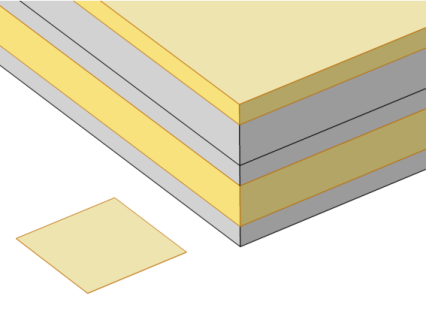Almost all physics nodes that you add in the Electric Currents, Layered Shell interface have a section named Layer Selection. Selections there interact with the standard selections of geometrical objects (boundaries and edges) in order to provide a complete specification of where a material property or boundary condition is to be applied.
The default selections in the Layer Selection section differ between different physics features. This reflects the fact that some physics features (such as the
Layered Shell feature) are more likely to be applied to all layers, whereas other features (such as the
Homogenized Shell Connection) are more likely to be used for a single layer or interface.
In the Layer drop-down list, you can select
If you select All layered materials, you cannot control individual layers; the contribution is given to all layers. All information is taken from the definitions made in the layered material features (
Layered Material Link,
Layered Material Stack, or
Single Layer Material) under
Materials in the current component. This means that a single physics node can accommodate several different stacking sequences. As geometrical selection, you can use any object selected in any of the layered material features.
If you select an individual Layered Material Link,
Layered Material Stack, or
Single Layer Material, then you can only select geometrical objects which are part of the selections of that feature. In most cases, you will get access to a list of check boxes where you can further limit the contributions to individually selected layers or interfaces to which this contribution is to be added.
This is illustrated by Figure 4-6 and
Figure 4-7, where the patch at the lower left is the actual shell, and the 3D sketch shows an expanded view of what it would represent in the physical world.
This is illustrated by Figure 4-8 and
Figure 4-9, where the patch at the lower left is the actual shell, and the 3D sketch shows an expanded view of what it would represent in the physical world.
